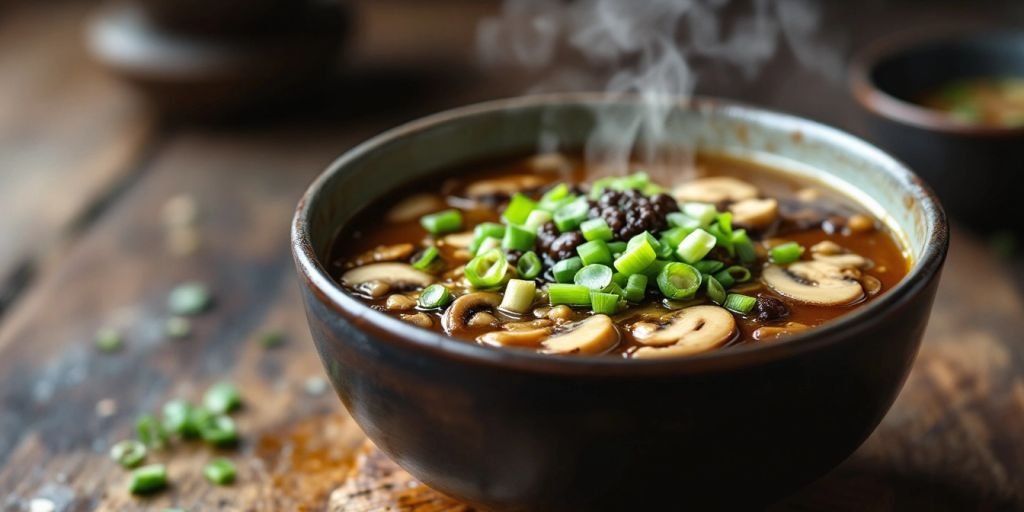Miso and mushroom soup is a delightful dish that combines rich flavors and healthy ingredients. This comforting soup is not only warm and satisfying, but it also offers a variety of health benefits. In this article, we will explore the secrets behind making the perfect miso and mushroom soup, from understanding its basic ingredients to enhancing its flavor and serving it right. Join us on this culinary journey and discover how to create a bowl of happiness with miso and mushroom soup!
Key Takeaways
- Different types of miso, like white and red, bring unique flavors to the soup.
- Cleaning mushrooms properly helps maintain their texture and flavor.
- Cutting vegetables evenly ensures they cook at the same rate for a balanced taste.
- Adding miso at the end of cooking preserves its flavor and health benefits.
- Pairing the soup with proteins like chicken or tofu enhances the meal experience.
Understanding the Basics of Miso and Mushroom Soup

Miso and mushroom soup is a delightful dish that combines rich flavors and healthy ingredients. The key components of this soup are miso and mushrooms, which work together to create a comforting bowl of goodness.
Types of Miso Used in Soup
There are several types of miso that can be used in soup:
- White Miso: Mild and slightly sweet, great for beginners.
- Red Miso: Stronger flavor, perfect for those who enjoy a deeper taste.
- Mixed Miso: A blend of both, offering a balanced flavor.
Common Mushroom Varieties for Soup
Mushrooms add texture and earthiness to the soup. Here are some popular choices:
- Shiitake: Rich in flavor and often used in Asian dishes.
- Button: Mild and versatile, suitable for any soup.
- Portobello: Meaty texture, great for a heartier soup.
Basic Ingredients and Their Roles
The basic ingredients in miso and mushroom soup include:
- Miso: Provides umami flavor and depth.
- Mushrooms: Add texture and absorb flavors well.
- Carrots: Introduce sweetness and color.
- Onion: Adds aromatic depth.
- Green Onion: Fresh garnish that enhances taste.
Miso soup is not just a dish; it’s a comforting experience that warms the soul. The combination of fresh ingredients and the rich taste of miso makes it a favorite for many.
In summary, understanding the basics of miso and mushroom soup involves knowing the types of miso, the mushrooms that can be used, and the roles of each ingredient. This knowledge sets the foundation for creating a delicious and satisfying soup.
The Art of Preparing Miso and Mushroom Soup
Cleaning and Prepping Mushrooms
To start, it’s important to clean your mushrooms properly. Avoid washing them under running water; instead, use a soft brush to remove any dirt. This helps keep them from getting soggy. Once cleaned, slice them into even pieces to ensure they cook uniformly.
Cutting Vegetables for Uniform Cooking
When preparing your vegetables, aim for consistent sizes. This ensures that everything cooks evenly. Here are some key vegetables to include:
- Mushrooms: For texture and flavor.
- Carrots: Add a touch of sweetness and color.
- Onions: Provide aromatic depth.
Adding Miso at the Right Time
The timing of adding miso is crucial. Always add it towards the end of cooking. Boiling miso can ruin its flavor and health benefits. Stir it in gently and let it dissolve for about a minute before serving. This way, you maintain the rich umami flavor that makes the soup special.
Remember, the secret to a great miso soup lies in the balance of flavors and the quality of your ingredients. Enjoy the process!
Enhancing the Flavor of Miso and Mushroom Soup
Using Dashi for a Flavorful Base
To create a rich and savory soup, start with dashi, a traditional Japanese stock. Dashi adds depth and enhances the umami flavor of the soup. You can make it from scratch using kombu (seaweed) and bonito flakes, or use instant dashi powder for convenience. Using dashi is key to a delicious soup!
Incorporating Aromatics like Ginger and Garlic
Adding aromatics can elevate your soup’s flavor. Consider these options:
- Ginger: Adds warmth and a slight spice.
- Garlic: Provides a rich, savory note.
- Onions: Contributes sweetness and depth.
These ingredients should be sautéed before adding the broth to release their flavors.
Balancing Umami with Sweet and Sour Elements
To achieve a well-rounded flavor, balance the umami of miso and mushrooms with sweet and sour elements. Here are some ideas:
- Sweet: Add a splash of mirin or a pinch of sugar.
- Sour: A dash of rice vinegar or lemon juice can brighten the soup.
- Saltiness: Adjust with soy sauce if needed.
By carefully balancing these flavors, you can create a soup that is both comforting and complex.
Remember, the secret to a great miso and mushroom soup lies in the balance of flavors. Experiment with different ingredients to find your perfect combination!
Serving and Pairing Miso and Mushroom Soup
Ideal Side Dishes to Serve
When it comes to serving your delicious miso and mushroom soup, consider these tasty side dishes:
- Steamed Rice: A classic choice that complements the soup’s flavors.
- Grilled Vegetables: Adds a nice crunch and variety to your meal.
- Salad: A fresh side can balance the warmth of the soup.
Pairing with Proteins like Chicken and Tofu
For a complete meal, pair your soup with proteins such as:
- Grilled Chicken: Its smoky flavor enhances the soup.
- Tofu Steaks: A great vegetarian option that absorbs the soup’s umami.
- Shrimp: Adds a seafood twist that works well with the broth.
Garnishing Tips for Presentation
To make your soup visually appealing, try these garnishing tips:
- Chopped Green Onions: Sprinkle on top for a fresh look.
- Sesame Seeds: Adds a nutty flavor and a nice crunch.
- Fresh Herbs: A few leaves of cilantro or parsley can brighten the dish.
Remember, presentation matters! A well-garnished bowl of soup not only looks inviting but also enhances the dining experience.
Enjoy your comforting bowl of miso and mushroom soup with these delightful pairings and sides!
Storing and Reheating Miso and Mushroom Soup

Proper Storage Techniques
To keep your miso soup fresh, follow these steps:
- Cool the soup to room temperature within 4 hours before storing.
- Use an airtight container to prevent any odors from the fridge affecting the soup.
- Store in the refrigerator for up to 2 days for the best flavor.
Reheating Without Losing Flavor
When it’s time to enjoy your leftover soup, remember:
- Heat gently over medium-low heat.
- Avoid boiling, as this can ruin the delicate flavors of the miso.
- Stir occasionally to ensure even heating.
Making Soup in Advance for Meal Prep
If you want to prepare your miso soup ahead of time:
- Prepare the broth and vegetables, but add the miso only when you’re ready to serve.
- You can freeze the soup for up to 2 weeks, but remember to remove any tofu before freezing to maintain its texture.
Keeping your miso soup fresh and flavorful is key to enjoying its rich taste. By following these simple storage and reheating tips, you can savor every bowl!
Exploring Variations of Miso and Mushroom Soup
Seasonal Ingredients to Try
When making miso and mushroom soup, consider using seasonal ingredients to enhance the flavor. Here are some ideas:
- Spring: Add fresh asparagus or peas for a pop of color and sweetness.
- Summer: Incorporate zucchini or corn for a light, refreshing taste.
- Fall: Use pumpkin or butternut squash for a creamy texture.
- Winter: Try root vegetables like carrots and parsnips for warmth.
Vegan and Vegetarian Adaptations
For those following a vegan or vegetarian diet, there are plenty of ways to enjoy this soup:
- Substitute traditional dashi with a vegan dashi made from kombu and shiitake mushrooms.
- Use tofu or tempeh as a protein source instead of meat.
- Experiment with different types of miso, such as white or red, to find your favorite flavor.
Regional Differences in Recipes
Miso and mushroom soup varies by region, reflecting local tastes and ingredients. Here are a few examples:
- Japanese Style: Often includes enoki mushrooms and a light dashi base.
- Korean Style: May feature shiitake mushrooms and gochujang for a spicy kick.
- Western Style: Might incorporate cream for a richer texture and flavor.
Exploring different variations of miso and mushroom soup can lead to delightful discoveries. Whether you stick to traditional recipes or venture into new territory, each bowl offers a unique experience.
In conclusion, don’t hesitate to get creative with your ingredients. The beauty of miso and mushroom soup lies in its versatility, allowing you to tailor it to your taste preferences and dietary needs. Enjoy experimenting!
Health Benefits of Miso and Mushroom Soup

Nutritional Value of Miso
Miso is a fermented soybean paste that is rich in essential amino acids, vitamins, and minerals. It provides a robust nutritional profile, making it a great addition to your diet. Here are some key nutrients found in miso:
| Nutrient | Amount per 100g |
|---|---|
| Protein | 12g |
| Vitamin B | 0.5mg |
| Vitamin E | 0.5mg |
| Vitamin K | 2.5mcg |
Health Benefits of Mushrooms
Mushrooms are not just tasty; they also offer numerous health benefits. They are low in calories and high in nutrients. Some benefits include:
- Boosting the immune system
- Providing antioxidants
- Supporting heart health
Incorporating Soup into a Balanced Diet
Adding miso and mushroom soup to your meals can enhance your overall health. Here’s how:
- Include it in your lunch for a nutritious boost.
- Pair it with whole grains like brown rice for a complete meal.
- Enjoy it as a starter before your main course to aid digestion.
Miso and mushroom soup is not just a comforting dish; it’s a powerhouse of nutrition that can easily fit into a healthy lifestyle. Enjoying this soup regularly can contribute to your overall well-being.
Miso and mushroom soup is not just tasty; it’s also packed with health benefits! This warm dish can boost your immune system and improve digestion. If you want to learn more about how to make this delicious soup and discover other healthy recipes, visit our website today!
Final Thoughts on Miso and Mushroom Soup
In conclusion, making your own mushroom miso soup is a rewarding experience that brings warmth and comfort to any meal. By choosing the right miso and preparing fresh ingredients, you can create a delicious bowl of soup that is both healthy and satisfying. Remember to add the miso at the end of cooking to keep its flavor strong. Whether you enjoy it alone or with a tasty side, this soup is sure to please. So, gather your ingredients and enjoy the simple pleasure of a homemade bowl of miso and mushroom soup!
Frequently Asked Questions
What types of miso are best for soup?
There are a few types of miso you can use, like white, red, and mixed. White miso is sweeter and lighter, while red miso has a stronger flavor. Choose according to what you like!
How should I prepare mushrooms for the soup?
Instead of washing mushrooms, just brush off any dirt. Washing can make them too wet and mushy.
Why is it important to cut vegetables evenly?
Cutting vegetables into similar sizes helps them cook evenly, so every bite tastes great!
When should I add miso to the soup?
You should add miso at the end of cooking. If you boil it too long, you can lose its flavor and health benefits.
What are some good dishes to serve with miso soup?
Miso soup goes well with many meals! You can try it with grilled chicken, tofu, or even sweet and sour pork.
How should I store leftover miso soup?
If you have leftover soup, keep it in the fridge and eat it within two days. When reheating, do it gently to keep the flavor.




